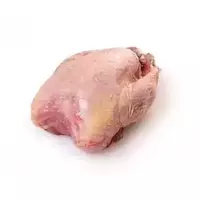Partridge meat

Partridges belong to the Pheasant family of the Kuroiform order. These birds live in the north of America, Asia and Europe mainly in birch and aspen groves, tundra, as well as in forest swamps.
As you know, the season of hunting for partridges is opened in August, and it continues until the last autumn days. By the way, today they are bred in artificial conditions, since partridge meat belongs to delicacies and is very highly valued. The useful properties of partridges for human health are also important.
When choosing a partridge carcass, you need to carefully consider the skin under the wings - young individuals are characterized by very soft, thin and elastic. Partridge meat is unusually tender and tasty. By the way, it is recommended to use partridge meat for banquets, whose breast remained intact, and only legs or wings were damaged during shooting.
Most often, you can buy partridge meat in a frozen state. Before preparing the carcass, it must be processed by cutting the abdominal cavity, and then carefully removing all the insides. Moreover, the eyes of the bird are also pre-removed, and the neck with the head turns under the wing. The claws on the legs are necessarily cut off and the legs themselves are carefully cleaned, folded behind the back and bandaged.
Partridge meat is loved and highly valued in many world countries. For example, in Russia, it is customary to fry partridge meat on a medium heat, German residents stew it with vegetables, and French chefs prepare delicious broths from this bird. Italians use partridge meat to make salads, pizzas and pies, and Greeks like to serve cooked poultry with side dishes of potatoes or rice.
Types of partridges
As you know, there are 3 main species of partridges, among which the partridge is white, gray and stone, also known as cockerel. The body size of the white partridge is on average up to 38 centimeters with a weight of 400-870 grams. It is noteworthy that in winter the plumage of the white partridge becomes snowy white, while in the rest of the year the bird is characterized by brown-brown color.
The weight and size of gray is almost the same as that of the first species of partridge. It is characterized by gray plumage, and there is a brown semicircle on the breast. Grey partridge meat features a rich dark pink hue.
The smallest in size is considered the third species of partridge - feces, whose maximum weight hardly exceeds 400 grams. Against the background of other representatives of this family, these partridges are distinguished by a motley, mainly black and white color with red legs and beak. Their tender meat is also a dark pink hue.
partridge meat 253.9 kCal
Energy value of partridge meat (Ratio of proteins, fats, carbohydrates - ju):
Proteins: 18 g (~ 72 kCal)
Fats: 20 g (~ 180 kCal)
Carbohydrates: 0.5 g (~ 2 kCal)
Energy ratio (bj | y): 28% | 71% | 1%
 Español
Español Français
Français Português
Português Русский
Русский 简体中文
简体中文 繁體中文
繁體中文 日本語
日本語 한국어
한국어 العربية
العربية Türkçe
Türkçe Қазақ
Қазақ Deutsch
Deutsch Italiano
Italiano Українська
Українська
